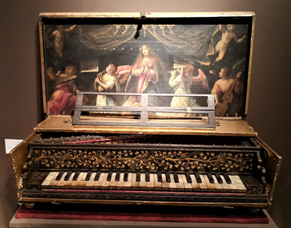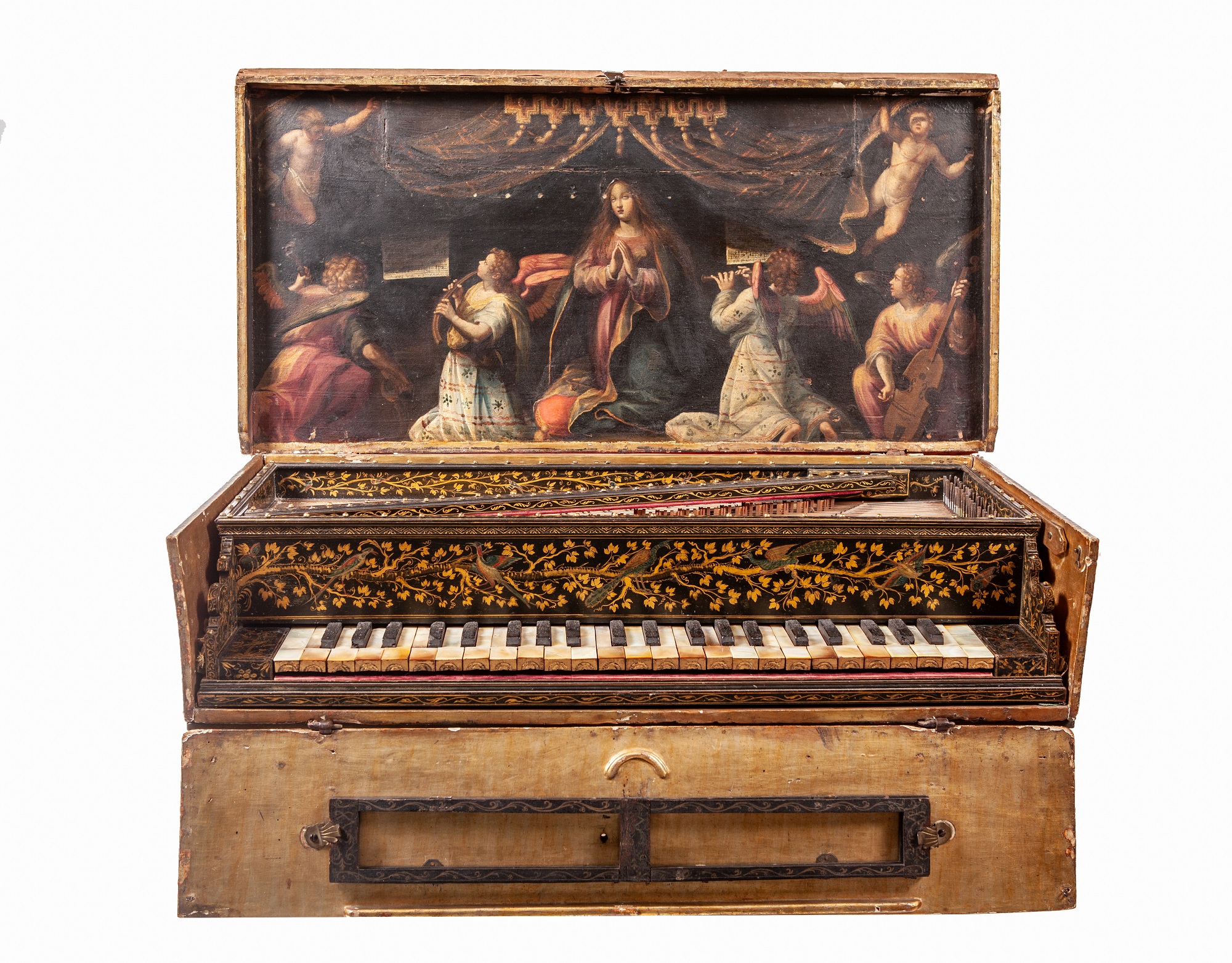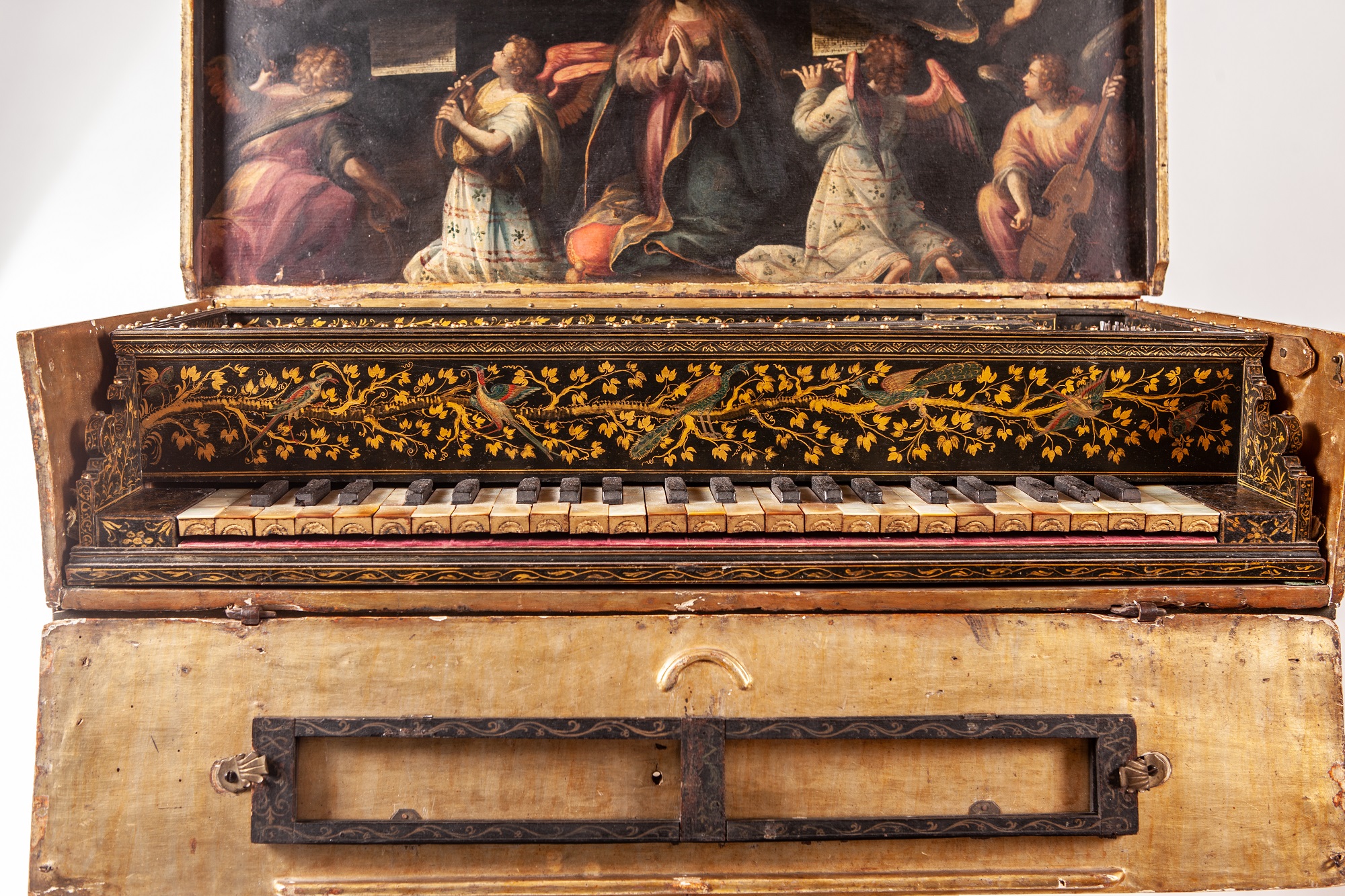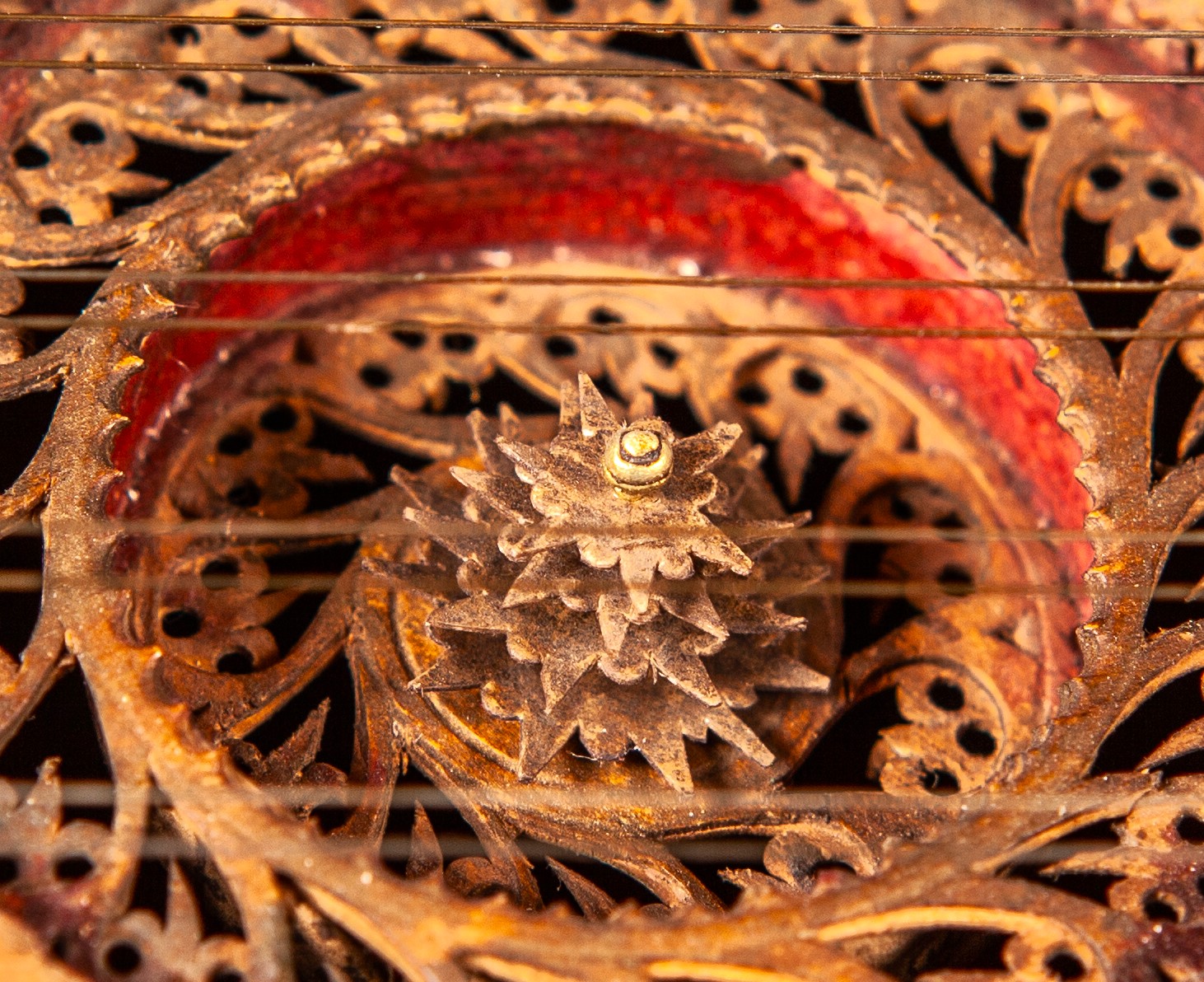ITALIAN SPINET 16th century
Léonora d’Esté, (1515-1575) princess, nun and musician.
The gold leaf decoration painted on the throat and around the edge of the soundboard represents golden vines on which exotic birds are arranged.
We find the description of this decoration in the account book of the “Camora Ducalo Munigione e Fabrichi” of October 14, 1536 in which we can read that the workshop of Tommaso da Trevisio the younger is occupied with the decoration of a case of a spinet for the nun Eleonora d’Este. It is painted with pheasants and golden foliage…
The keyboard has steps plated with mother-of-pearl and feints decorated with geometric patterns. The painting inside the lid shows in its upper part the seven flames of the Meditations of Saint Bernardine of Siena (1380-1444) on the words of the Virgin Mary considered as seven sacred flames. We find the presence of these seven flames in the seven spiritual weapons against evil, taught by Saint Catherine of Bologna, (c.1413-1463) responsible for the training of novices at the convent of Ferrara in which Eleonore d’Este took her vows.
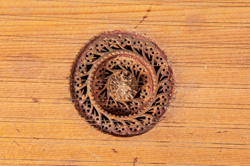
Table spinet characteristic of models played in the 16th century to accompany singing.
The 45-note keyboard (E-C) has mother-of-pearl-plated steps and black-painted feints bearing traces of golden patterns.
The soundboard is made of spruce, a rarity at that time, (1) for which the use of cypress was the norm. (The use of spruce will tend to become widespread in the following century.)
The two-tiered rosette is made of cut parchment.
The sides of the body are in cypress, as usual, and the instrument itself is housed in a protective and presentation case characteristic of Italian craftsmanship.
The keyboard flap, gilded on its inside, supports a folding lectern, decorated with the same motifs as those of the feints.
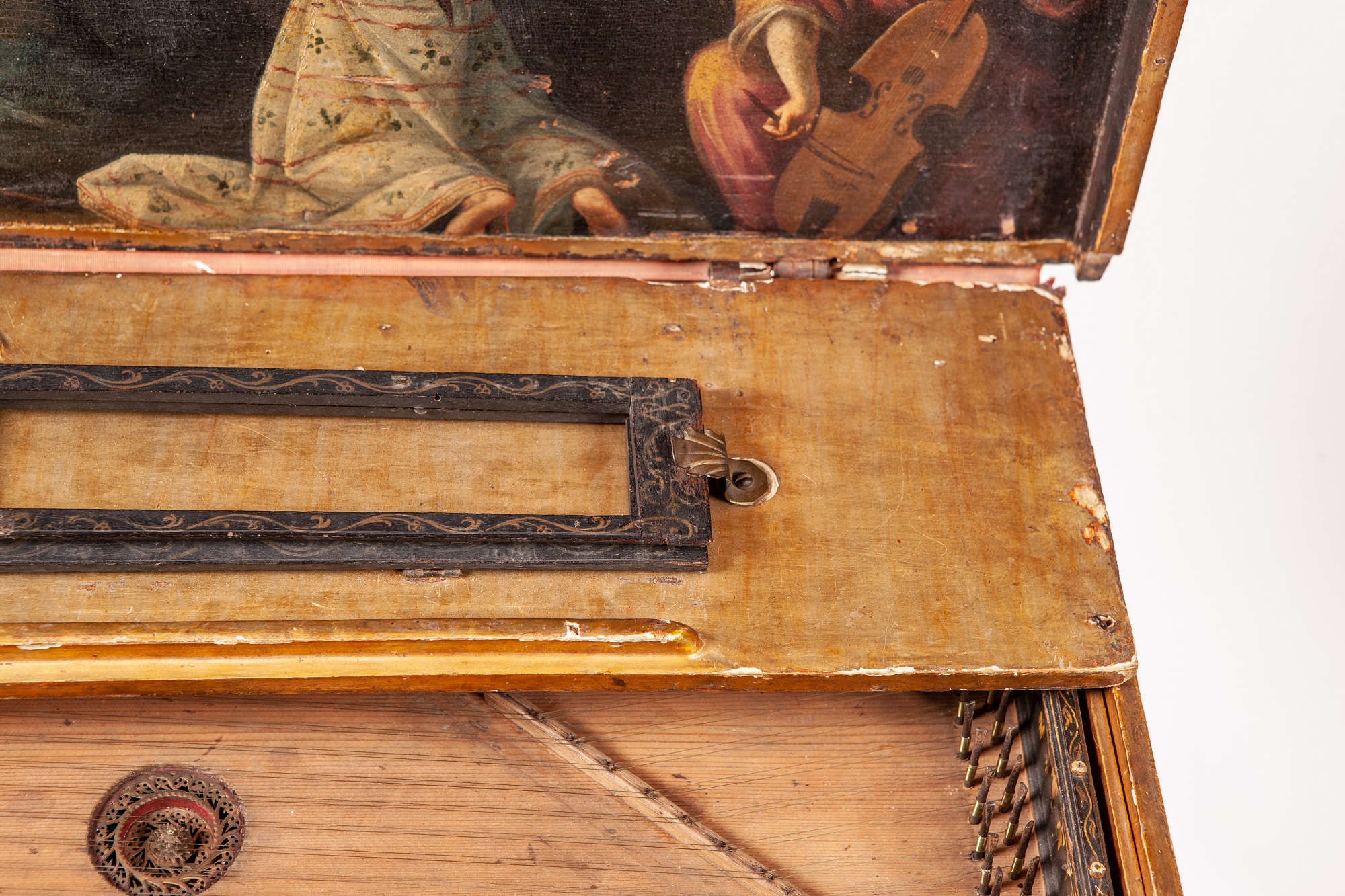
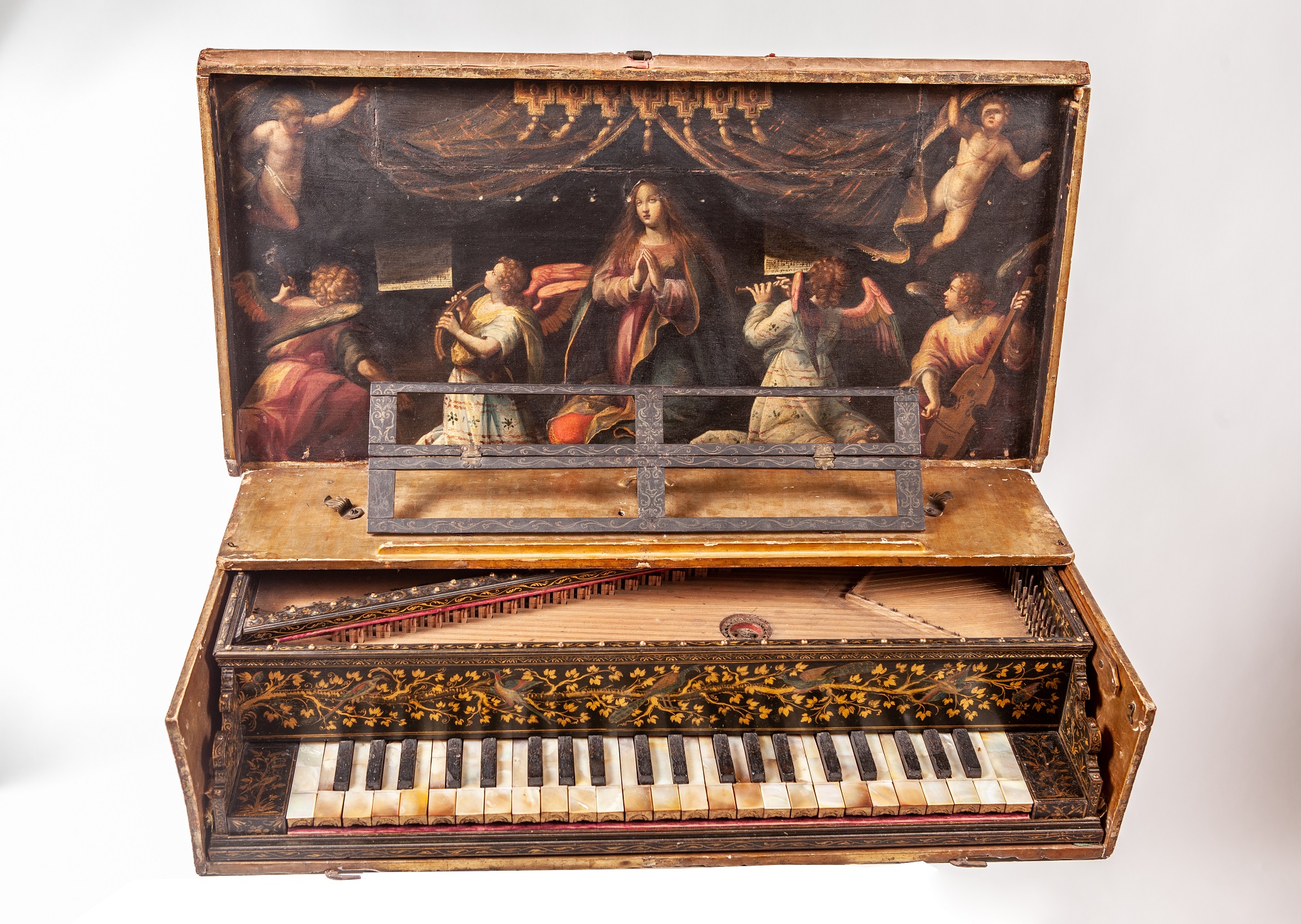
This lectern can be placed directly on the instrument in order to allow the reading of the score at the same time as its execution. (2)
The decoration painted on the throat and the circumference of the body represents golden vines where exotic birds are arranged.

This decoration corresponds to the description given in the account book of the “Camora Ducalo Munigione e Fabrichi” of October 14, 1536 in which one can read that the workshop of Tommaso da Trevisio the younger was asked to take care of of the decoration of a spinet for the nun Eleonore d’Este. It is painted with pheasants and golden foliage…(3)

This spinet is the only model listed that has this original decor whose golden patterns are repeated around the edge of the table. The edge of the sides and the capital are also enriched with small turned ivory cabochons. If this fashion is regular on the Italian keyboards of the Renaissance, the use of ivory rather than bone is exceptional.
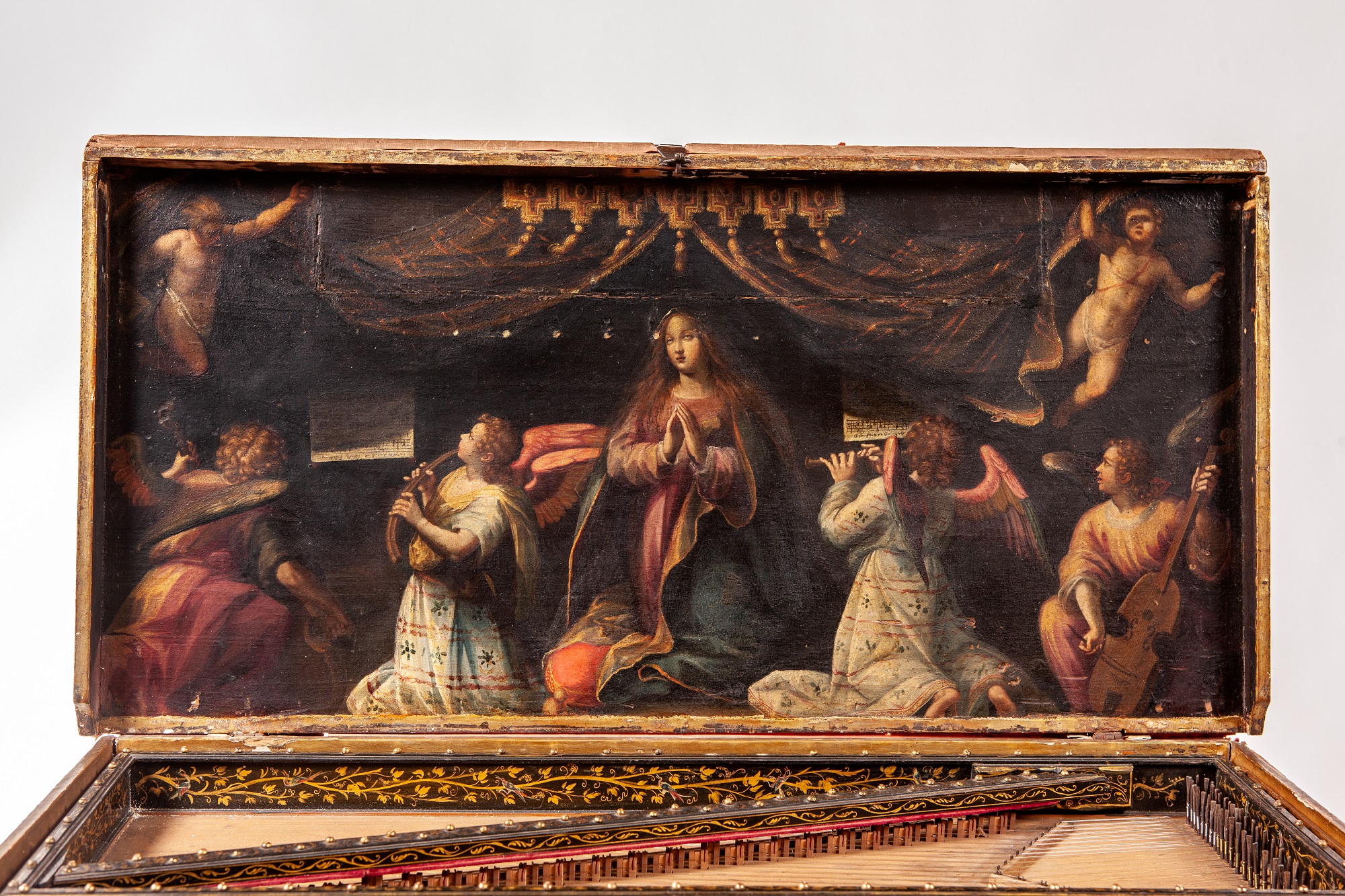
The interior painting of the lid, typical of the Mantua school, represents a praying woman (Saint Catherine of Bologna?) surrounded by angel musicians playing instruments of the time; Recorder, cornet, bass viol.
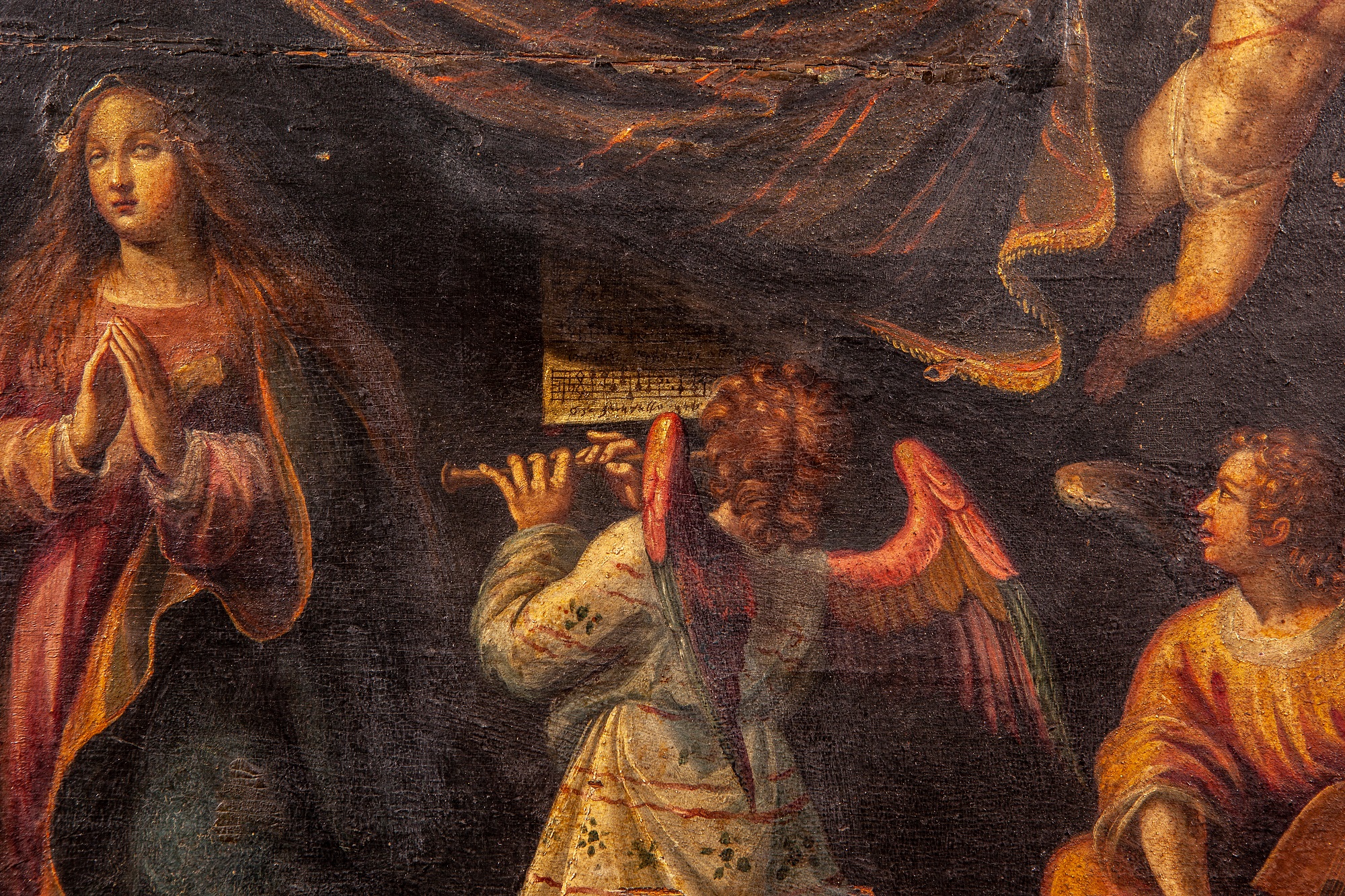
Recorder and cornet players.
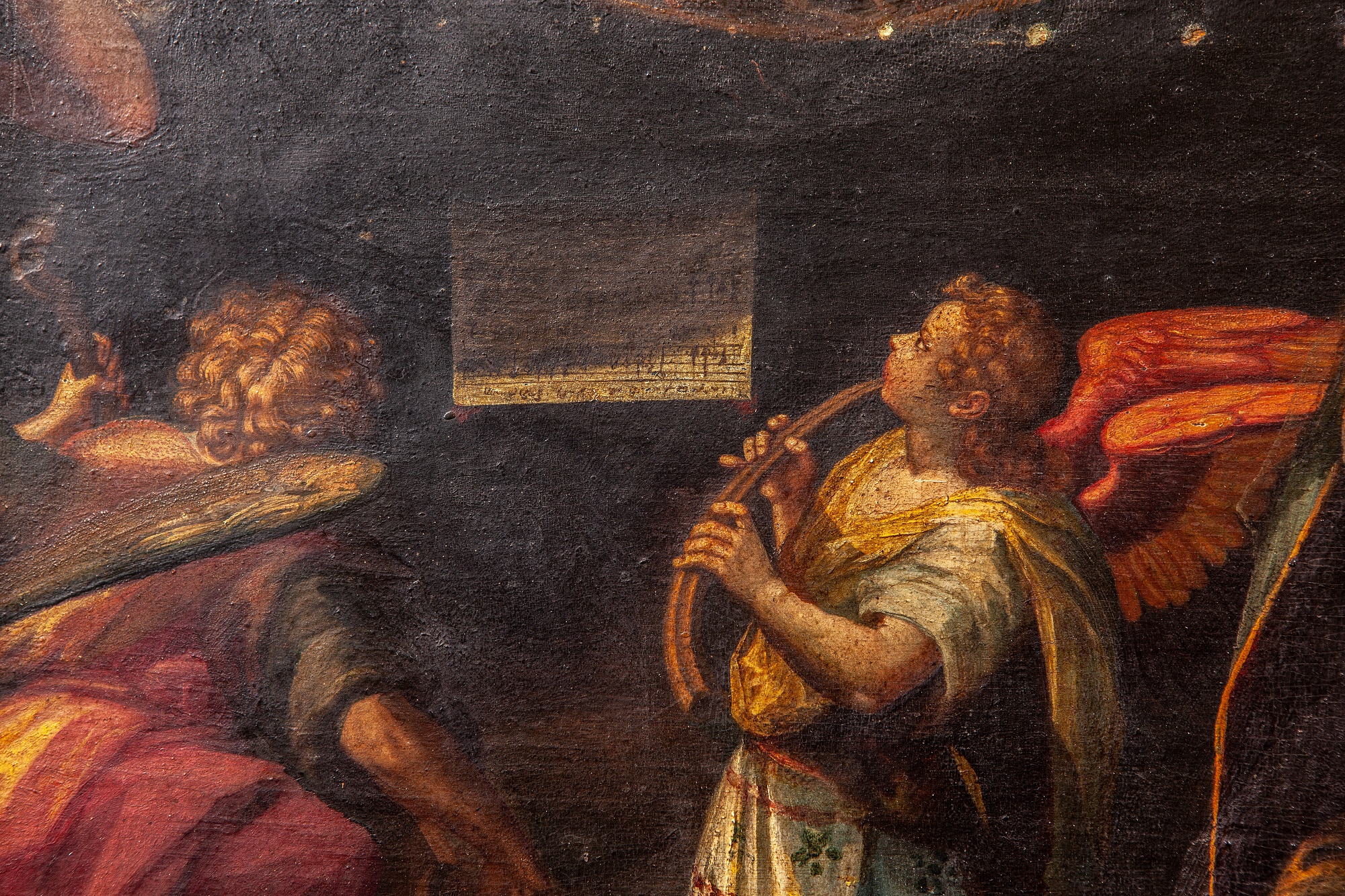
The painting presents in its upper part the seven flames of the Meditations of Saint Bernardin of Siena (1380-1444) on the words of the Virgin Mary considered as seven sacred flames. Bernardin of Siena was a preacher in Ferrara in 1417, during the plague epidemic.
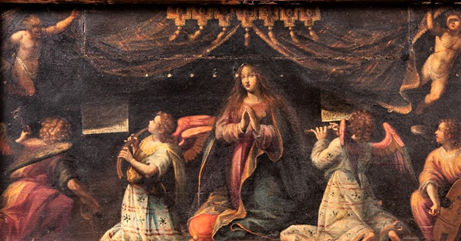
One cannot help but compare these seven flames to the seven spiritual weapons, against evil, explained by Saint Catherine of Bologna, (c.1413-1463) dedicated to the formation of novices at the convent of Ferrara in which Eleonore d’Este will pronounce his vows.
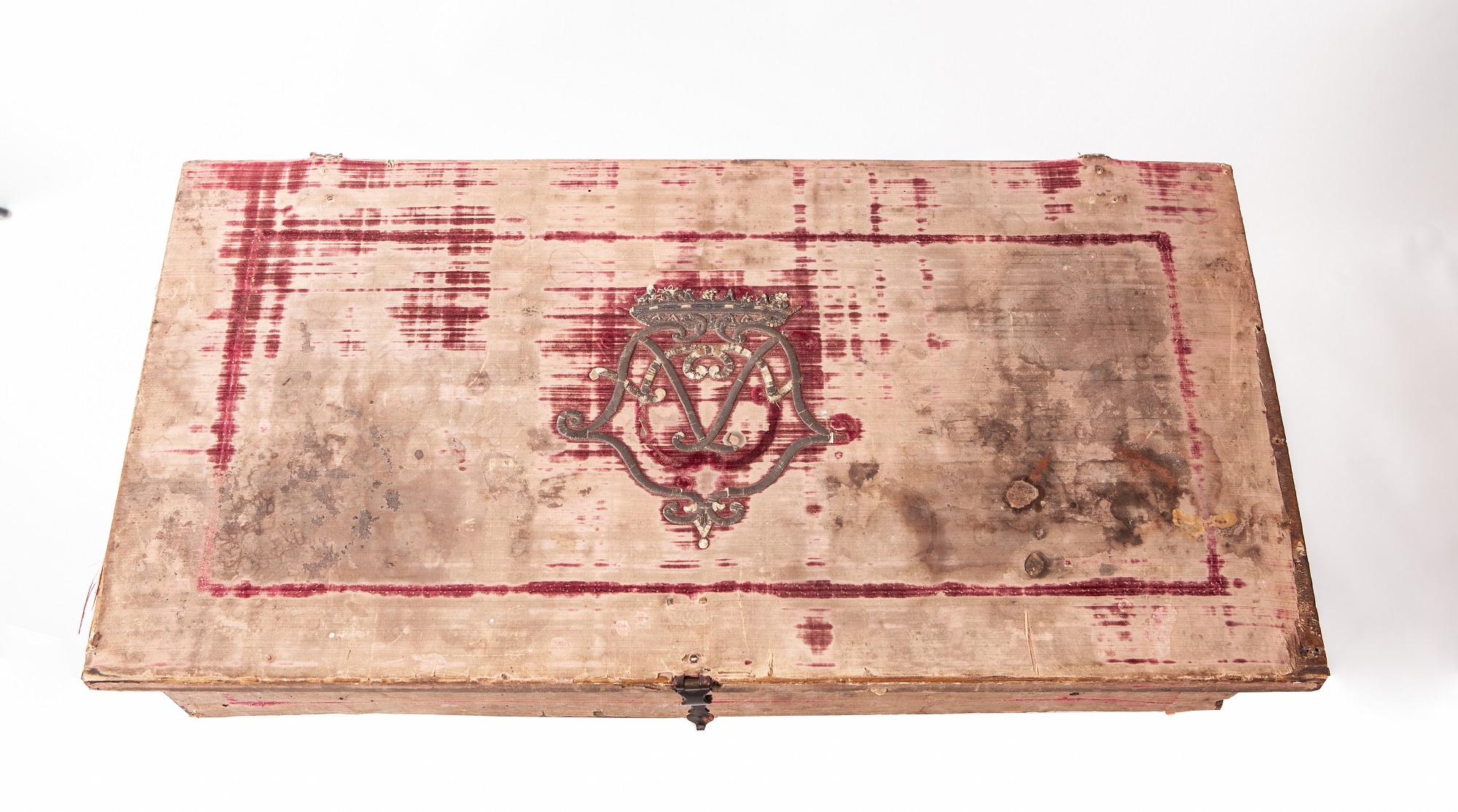
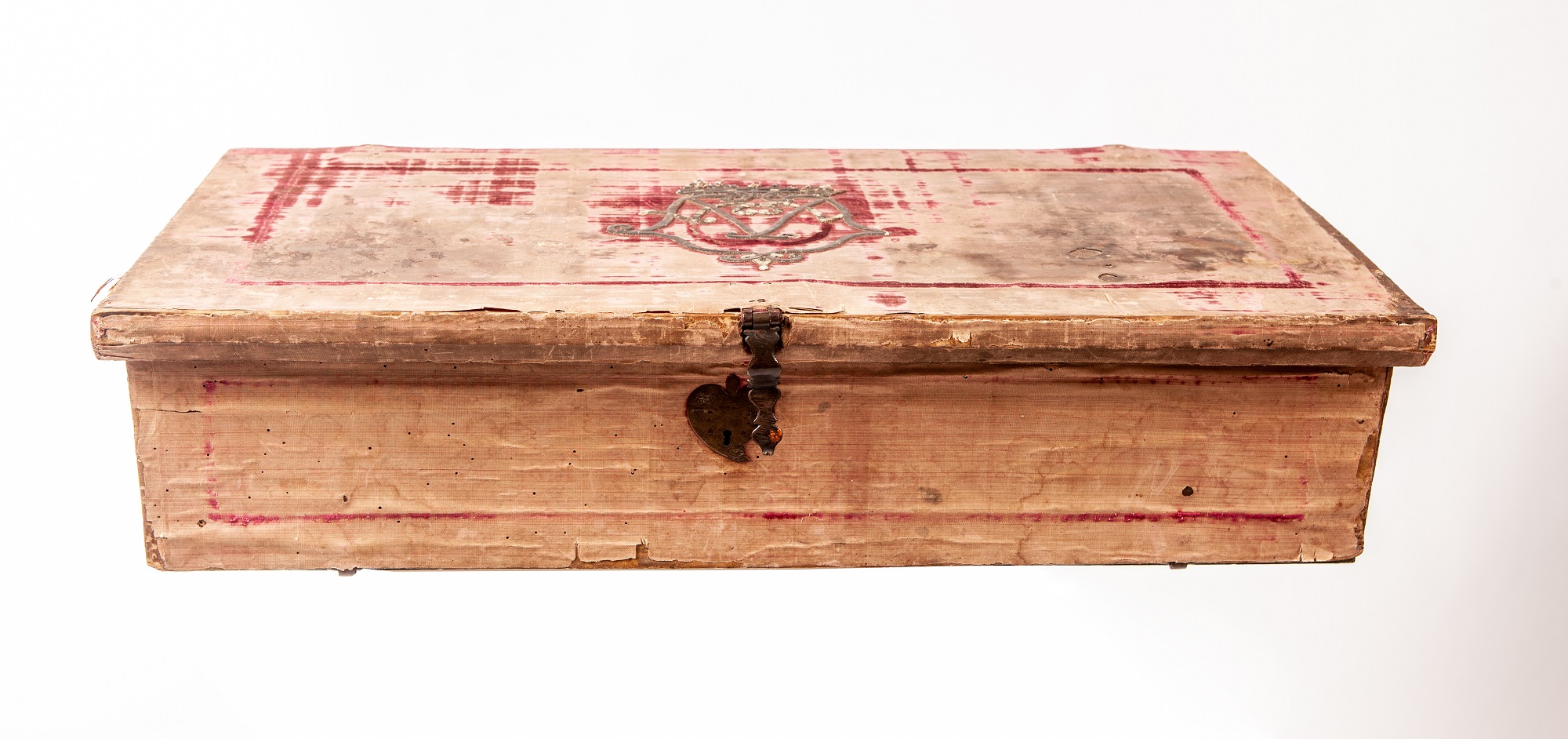
The body is covered with a crimson silk velvet, strongly exposed. The trace of a reserve in golden trimmings is visible on each side and the family cipher surmounted by a ducal crown is embroidered with gold thread in the center of the lid. (4)
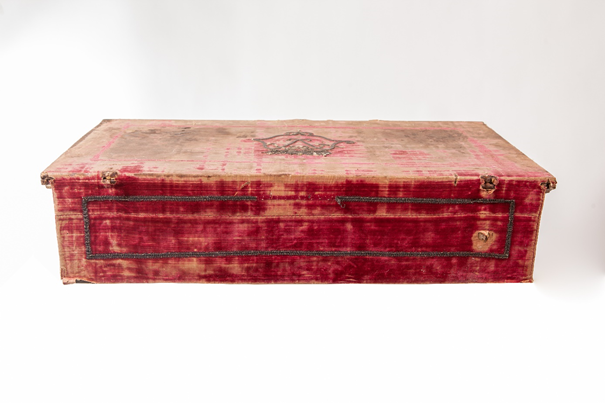
This instrument has been attributed to Alessandro Trasuntino (c.1485 – c.1545) who, around 1534, lived near the “Chiesa de la salute” in Este. (5)
He befriended Pietro Aretino (1492-1556) as evidenced by this letter sent from Venice on April 7, 1540, in which “Aretino” seems to refer to a collaborative project between Trasuntino and Titian.
“To Monsieur Allessandro [Trasuntino] of the organs [whom I consider here as a brother] I have established between you, who are the light of your art and Tiziano who is the splendor of his profession, the most laudable, the most honorable pact and the most graceful that between two [characters] so noble, so kind, and so fiery could ever stand.
It is in this case that you have to make him work one of those machines, which with the sweet harmony put the souls in the prey of ecstasy and that in exchange for that he must give you one of those copies, which with living nature brings beings back into the arms of stupor. But as the ingenuity of excellent men is exercised only in time, it seemed to me that I put a delay of two months between the completion of his work and yours. In the meantime, sight and hearing (priority to the other senses) are supposed to be included in the harpsichord that you will make of it and in the portrait that it will make of you, the ultimate goal of the perfection that is essential in a thing and in the other. Although it makes you dream how many images and how many tools will never come out of his only brush and your only hands? (6)
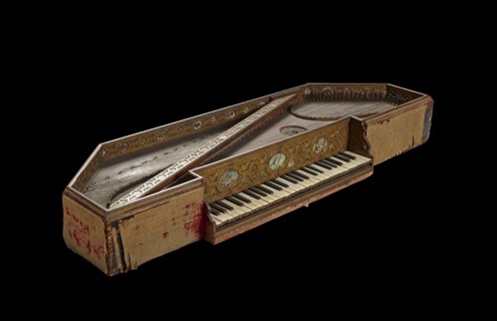
Virginal by Giovanni Celestini, dated 1593.
Royal College of Music, London. (RCM 176)
The body of the instrument is covered with the same crimson velvet and strongly insolated
Between 1626 and 1627, many objects belonging to the Gonzaga family, then heavily in debt, were sold. The Flemish art dealer Daniel Nijs (or Nys) (1572-1647) residing in Venice, organized the sale of a large part of the collection of the Dukes of Mantua as part of the largest art contract of the 17th century . Her role in regularly supplying the Gonzagas with jewelry and luxury items had opened the doors of the Maison d’Este to her and made her aware that she might be interested in an offer to purchase his works of art, regard to the size of the accumulated debts.
The Chancellor of Mantua, Alessandro Striggio (1573-1630) (son of the composer) repeatedly negotiated the content of the sale and the price of the objects, before Nijs finally completed the transaction by agreeing to pay Ferdinando’s successor Gonzaga, Vicenzo II, for a substantial number of paintings, sculptures and works of art.
The spruce then came into the possession of one of the ancient noble families of Mantua where it was kept until the 20th century.
Notes
(1) Information given by Jean-Claude Battault, conservation technician at the Musée de la Philharmonie, when observing the instrument on site.
(2) We do not know of any other spruces exhibiting this process.
(3) The word “pheasant” could be applied to different birds, ranging from the European pheasant, known as Colchis, to peacocks or lyre birds from India… This generic term still appears in the 18th century Encyclopedia.
(4) The study in progress of the number embroidered on the outer velvet of the case will perhaps make it possible to find the name of the family who acquired it in 1626…
(5) Archives of the Priory of the “Church of Health” on the succession of his son Francesco and the sale of his house.
(6) First book of letters of Aretino, Milan, vol.1, pp. 154-155. (nd)
Allessandro [Trasuntino] dagli organi ecco fratello, ch’io ho fermato tra voi, che sete il lume de l’arte vostra e Tiziano ch’lo splendour del mestier suo il piu laudabile, il piu onorevole e il piu grazioso patto che tra due cosi nobili, cosi gentili e cosi alti spiriti si potesse mai fermare.
E il caso e che voi deviate lavorargli una di quelle machine, che com il soave de l’armonia danno l’anime in preda de lo esrasi e che egli in cambio di cio debba diningervi in un di quegli esempli, che con il vivace de la natura riducano le persone in braccio de lo stuppor. Ma perche lo ingenio degli uomini eccelenti non si prevale di se stesso se non in tempo, mi e parso di metter due mesi di termine tra il compiere de la sua opera e de la vostra. Intanto il viso e l’audito (preclari degli altri sensi) spettano di comprendere ne lo arpicordo che voi farete a lui e nel ritratto che egli fara a voi lo ultimo fine de la sua perfezione che si richiede ne l’una cosa e ne l’altra. Benche cio movera ad invidia quante imagini e quanti stromenti uscir mai dal solo pennello suo e da le uniche mani Vostre.
Condition :
Due to the protection given by its box, the instrument is in a good state of conservation.
Parts of the mother-of-pearl veneers decorating the keys have been replaced.
Jumpers have been redone.
The painting on canvas decorating the inside of the lid shows traces of restoration.
Provenance:
– Bought in Italy in the second half of the 20th century.
– Private collection, London.
Dimensions: Instrument itself: 72.5cm x 35cm x 13.7cm.
Instrument in its box: 78cm x 39cm x 18cm.
